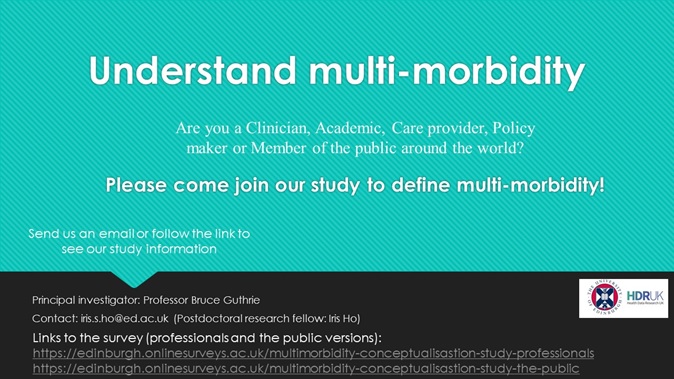By Iris Ho and Bruce Guthrie
Centre for Population and Health Sciences, Usher Institute, University of Edinburgh, United Kingdom


Many people, nowadays, are living with multiple chronic conditions. However, there remains no agreed method to measure this common phenomenon.
In research, there are varying conditions included in a multimorbidity measure. The number of conditions included in a measure can range from 2 to 285. As for selection of conditions, some included disease category (e.g. gastrointestinal disease), whereas others included relatively smaller disease category (e.g. chronic liver disease) or individual conditions (e.g. hepatitis, or liver cirrhosis).
In addition, methods used to count conditions differ across studies. There are two main types of counting methods. One is using a simple count of conditions to estimate how common multimorbidity is. The other type of measures is applying weights for each chronic condition based on disease severity and its impact on an outcome, and the total weighting score is used to predict the impact of multimorbidity on the outcome, such as mortality, physical disability, hospitalisation, or quality of life. Within each type of measures, researchers have used different reference definitions and weighting schemes while counting.
Due to the inconsistent definitions of multimorbidity and measurement methods, estimates of multimorbidity prevalence and burden cannot be directly compared across studies. Therefore, we want to gather your opinions and experience relevant to multimorbidity. Your opinions can help to shape future research, clinical and policy decisions on management of multimorbidity.
We are looking for:
1) Members of the public who are interested in multiple chronic conditions or have chronic illness experiences
2) Academics, clinicians, service providers, policy makers who are interested in multimorbidity or have undertaken multimorbidity-relevant work.
This study consists of two to four rounds of survey (most likely 2-3 rounds depending on when consensus is reached). The round-one survey is currently published online and the other rounds will be distributed subsequently later.
If you are interested in the topic and want to know more about this study, please get in touch with the researcher, Iris Ho (iris.s.ho@ed.ac.uk), or the principal investigator, Bruce Guthrie (bruce.guthrie@ed.ac.uk).
Thank you!

